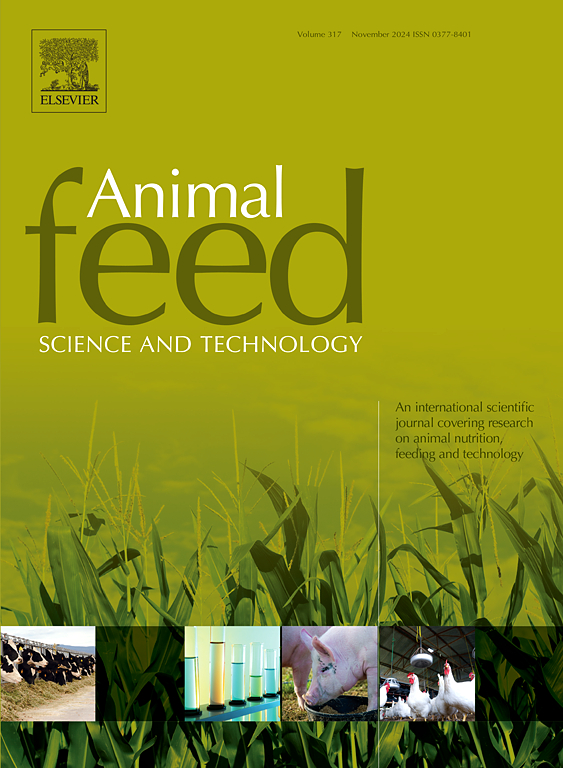Effects of hydrolysable tannin extract and dry matter concentration on ensiled legume and grass forages – Chemical composition, crude protein fractions and in vitro gas production kinetics
IF 2.5
2区 农林科学
Q1 AGRICULTURE, DAIRY & ANIMAL SCIENCE
引用次数: 0
Abstract
Pre-ensiling treatments can have a distinct impact on crude protein (CP) degradation and fermentation characteristics of ensiled high-protein forages. The objective of this study was to investigate the effects of different dosages of chestnut tannin (CT) and dry matter (DM) concentration on chemical composition, nitrogen (N) compounds as well as in vitro gas production (GP) in grass and legume silages. Pure stands of lucerne (Medicago sativa L.), Italian ryegrass (Lolium multiflorum L.) and red clover (Trifolium pratense L.) were harvested and wilted to DM contents of approximately 200 and 350 g/kg. The forages were then ensiled in 120-litre barrels with three levels of hydrolysable tannin (HT) supplementation (0, 20 and 40 g/kg DM). After ensiling, six silage treatments of each forage species were sampled for chemical analysis, particularly with regard to proximate constituents, fermentation products and other volatile compounds, CP fractions and 96-h in vitro gas production (GP) characteristics. In order to statistically evaluate the effects of HT and DM treatments, data were analysed using analysis of variance as well as orthogonal contrast test (linear and quadratic). In addition, the mean GP kinetics over time were estimated using nonlinear regressions. The stepwise increase of HT concentration linearly reduced the accumulation of non-protein-N (NPN) in all forages (P < 0.01) by at least 20 % in low DM silages and by 10 % in silages with a higher DM level. Both, HT and DM treatments resulted in a significant decrease (P < 0.05) of ammonia-N concentration. Among all forage species, the extent of proteolytic activities was highest in untreated low DM lucerne silages, as NPN and ammonia-N concentrations were 824 g/kg CP and 198 g/kg N, respectively, whereas the lowest CP degradation was generally determined in red clover silages. Maximum GP as well as organic matter digestibility (OMD) were negatively affected by increasing HT dosage in all forage species (P < 0.05), with the impact being more pronounced in moister silages. On the other hand, wilting to a higher DM content increased GP and OMD in red clover and Italian ryegrass silages. The present study revealed that HT markedly improved CP quality in silages due to higher stability of protein, whereas the DM treatment had more beneficial effects regarding fermentation quality, OMD and GP.
水解单宁提取物和干物质浓度对青贮豆科和禾本科牧草的影响。化学成分、粗蛋白质组分和体外产气动力学
青贮前处理对青贮高蛋白牧草的粗蛋白质降解和发酵特性有显著影响。本试验旨在研究不同剂量栗子单宁(CT)和干物质(DM)浓度对禾本科和豆科青贮化学成分、氮素(N)化合物及体外产气(GP)的影响。收获纯苜蓿(Medicago sativa L.)、意大利黑麦草(Lolium multiflorum L.)和红三叶草(Trifolium pratense L.),枯萎至DM含量约为200和350 g/kg。然后在120升的桶中青贮饲料,添加3个水平的水解单宁(0、20和40 g/kg DM)。青贮后,选取6个青贮处理进行化学分析,重点分析了近组分、发酵产物及其他挥发性化合物、CP组分和体外96 h产气特性。为了统计评价HT和DM处理的效果,采用方差分析和正交对比检验(线性和二次)对数据进行分析。此外,使用非线性回归估计了GP随时间的平均动力学。HT浓度的逐步增加线性降低了所有饲料中非蛋白氮(NPN)的积累(P <; 0.01),低干物质青贮的NPN积累至少降低了20 %,高干物质青贮的NPN积累至少降低了10 %。HT和DM处理均显著降低了氨氮浓度(P <; 0.05)。在所有饲料品种中,未经处理的低DM苜蓿青贮的蛋白质水解活性最高,NPN和氨氮浓度分别为824 g/kg CP和198 g/kg N,而CP降解最低的通常是红三叶草青贮。增加HT用量对最大GP和有机质消化率(OMD)均有负向影响(P <; 0.05),且在水分较丰富的青贮中影响更为显著。另一方面,凋萎至较高DM含量时,红三叶草和意大利黑麦草青贮的GP和OMD均增加。本研究表明,高温处理由于蛋白质的稳定性提高,显著提高了青贮CP品质,而DM处理在发酵品质、OMD和GP方面有更有利的影响。
本文章由计算机程序翻译,如有差异,请以英文原文为准。
求助全文
约1分钟内获得全文
求助全文
来源期刊

Animal Feed Science and Technology
农林科学-奶制品与动物科学
CiteScore
6.00
自引率
6.20%
发文量
266
审稿时长
3 months
期刊介绍:
Animal Feed Science and Technology is a unique journal publishing scientific papers of international interest focusing on animal feeds and their feeding.
Papers describing research on feed for ruminants and non-ruminants, including poultry, horses, companion animals and aquatic animals, are welcome.
The journal covers the following areas:
Nutritive value of feeds (e.g., assessment, improvement)
Methods of conserving and processing feeds that affect their nutritional value
Agronomic and climatic factors influencing the nutritive value of feeds
Utilization of feeds and the improvement of such
Metabolic, production, reproduction and health responses, as well as potential environmental impacts, of diet inputs and feed technologies (e.g., feeds, feed additives, feed components, mycotoxins)
Mathematical models relating directly to animal-feed interactions
Analytical and experimental methods for feed evaluation
Environmental impacts of feed technologies in animal production.
 求助内容:
求助内容: 应助结果提醒方式:
应助结果提醒方式:


